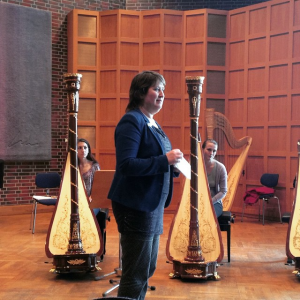Camac Blog
Two are better than one! An interview with Petra van der Heide and Anneleen Schuitemaker of the Concertgebouw Orchestra, Amsterdam.
News
April 15, 2024
Since 1888, the magnificent Concertgebouw has stood in splendour on the wide boulevard to which it has also lent its name. Its neoclassical pediments and imposing turrets have become a landmark synonymous with Amsterdam. For an equal length of time, the concert hall whose acoustics are amongst the finest in the world, has been home to the Concertgebouw Orchestra, a group revered internationally for sheer excellence in the realm of orchestral music.
For our readers, it is worth noting that the orchestra is unusual in that it supports two full-time positions for harpists: Petra van der Heide, who has been principal harp since 2003 (having formerly been principal harpist of the Opera in Darmstadt) and Anneleen Schuitemaker was appointed Second harp/ Assistant principal harp in 2020 (having been academist in several major german orchestras)
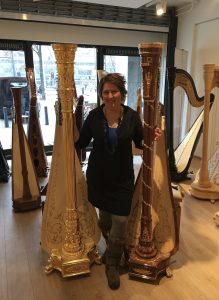
Petra van der Heide at the recent Camac harp days in Munich.
That the allocation of permanent two-harp positions is vanishingly small among professional orchestras, something which Petra van der Heide considers to be a great shame, and for the maintenance of which within the Concertgebouw she is justifiably proud:
“The absolute highest level you can achieve in an orchestra is with your permanent colleagues. And when you play a bowed string instrument, that is obvious […] for harpists, I think it’s even more important. I am really proud that we were able to keep the second harp position.”
In these straitened times, with funding to arts and culture seemingly under constant threat, it’s not just second, or co-principal positions that are under threat, but the single principal harp roles as well. As long-term principal harpists approach retirement, some orchestras are openly floating the idea of a new model in which freelance harpists are engaged on a ‘work-done’ basis. A reality not helped by a perceived myth about the lack of a permanent harpist being less relevant to the orchestra landscape: “Very sad, but it happens everywhere,” Says Petra, ruefully “And the managers of the orchestras believe that it doesn’t matter if one or the other is playing. Orchestra members do care. They want to have their permanent colleague.”
Anneleen Schuitemaker agrees: “I think it’s very nice because you know each other’s timing [..] the playing of course, but also around everything else. we just know each other so well and it’s easy and it saves energy”
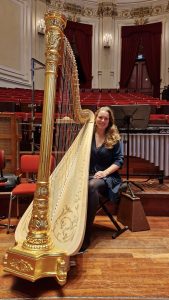
Anneleen Schuitemaker with her Camac Oriane harp at the Concertgebouw
Orchestral playing is very pressurised: working together can mean sensing the energy of the other player and learning that everyone has their own approach under this pressure and their own rituals, even. This is certainly a word that can be ascribed to the all important matter of tuning the harp.
“We actually tune simultaneously” Says Anneleen with a grin.
Petra explains: “Well, I of course have experienced situations where it [conditions for tuning] was not ideal. And when you have nervous harpists tuning and tuning and they can’t stop tuning because they’re so nervous and you have to tune three harps in the break. […] once I started to be first harp, I almost required in Amsterdam my substitutes to tune this way. Not because of me, but because I care as much about their tuning as my own.
And the good news is you can be sure right away that you fit together, because you TUNED together.”
The perfect colleague!
Within any organisation, the maxim ‘two are better than one’ is particularly apt when it comes to smooth running of a department, something which Petra learned from experience after a period of absence:
“We share the harps, we manage the strings together and the visiting harp technicians and I see especially orchestras where they don’t have permanent harpists [..] and see harps which are in a very bad condition because nobody cares. If I were out of the orchestra for a long time and there would be nobody [to oversee these matters] I trust Anneleen completely. It was great to have a fine colleague in situ, really”
Of course the benefits of two, permanent but complementary personalities are not only practical but musical. The job of a second harpist can be somewhat delicate, the music and approach are very different and shared experience can only help in this area. Anneleen explains: “I’m very flexible […] the main things are, of course, listening, and I imitate her movements as much as I can. And also sometimes I do some ‘fading in’ [a phased entry in exposed writing, to aid good ensemble].
I just have to be on the tip of my chair. It’s not always following. It’s sometimes also leading, like in La Mer [Debussy], for example. There are some pieces that the second harp has to lead. So, it’s not always like laid back and following, but also taking initiative.”
It is at this point that Petra finds it hard to contain her enthusiasm: “I think Anneleen is the great example of a very cooperative, flexible second harp. But she has also the skills to lead. […] I mean, she’s the perfect colleague, really. Write that down!”
Something for which both had reason to be grateful for during a recent performance of Schoenberg’s seminal (and in terms of the harp, daunting) Gurrelieder, with it’s four intricate harp parts (necessitating two guest players in addition), and where some moments were more exposed than others:
“Octaves!” Petra exclaims, referencing a particularly exposed octave in the low register at the conclusion of part 1 of Gurrelieder.
“And then four harps at the same moment, completely alone, nobody else playing. It was frightening. Every time that I played it, I was just hoping that everybody would follow but we did it almost every time, exactly at the same spot. I mean, we had a great conductor, he was very clear, Riccardo Chailly. But yeah, it was great.”
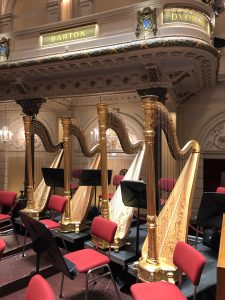
The four harps of the Concertgebouw (including two Camacs) on stage for Schoenberg’s Gurrelieder.
Petra and Anneleen also credit the extra players for the success of this performance.
I wondered aloud about the impact of playing as two harpists of the same nationality, and (in simple terms) the same school of playing:
“Well, I do agree what you’re saying about the Dutch harp school.” Petra muses “It comes, of course, from one big family started by Rosa Spier and Phia Berghout later, and then Edward Witsenburg and then, of course, Erika Waardenburg […] But I don’t believe that much in one or the other school because there are great players in every school.”
THE TOOLS OF THE TRADE
At this juncture, it would be disingenuous of us not mention Camac’s immense pride in the fact that the Concertgebouw has just acquired a second stunning, gilded Oriane harp from our ateliers, and added to the instrumental fleet of the harp section.
“I had the orchestra’s Camac already since 2008. And every possible solo cadenza I play on the Camac. Because it’s for me a more natural way of playing.”
Here Anneleen says:
“The funny thing is that sound-wise, Horngacher harps and Camac go very well together.” [the Concertgebouw now owns two of each]
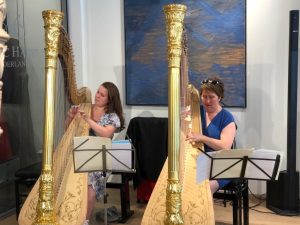
Anneleen and Petra trying out harps at the Camac Harpen Nederland showroom.
“That’s true!” Agrees Petra, but she points out:
“The differences between the players are so much bigger than the differences between the brands of the harps. If one needs to play Horngacher and the other Camac, we’ll manage to get that sound together.”
In all, for both players, the right instrument is about passion, and the ever-evolving art of musicians at the highest level, constantly searching, learning and raising their game: “I love Camac, because for me it’s a natural way. It fits to my body, it fits me. [but] I don’t believe like black and white in one kind of sound or kind; It is a very flexible process. I’m just trying to say it’s a continuous process. Yes, ongoing, but in a natural way, Camac fits to me.”
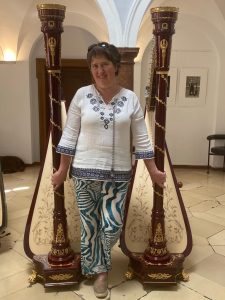
Petra van der Heide with two beautiful Camac Elysée harps.
Petra has had a Camac as her private harp since 1998, and recently added to her own collection of harps with a beautiful Elysée: “At the time that Anneleen found her Oriane [for the orchesta], I found my desired Élysée last year.”
It is the classic tale of a harpist who seems to find themselves shopping for a new harp without really realising it… Until it’s too late! “I was not looking for a harp at all. And it was such a coincidence when Camac was in Munich and I was in Munich […] And it was like, oh my God, I want this harp!”
Both agree that Camac’s passion for customer care is an important factor in our successful relationship with the artist:
“The Camac service is amazing. I’m telling everyone.”
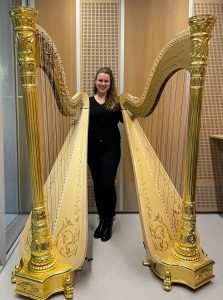
Anneleen with two Oriane harps during the visit of our technician, Guillaume Tijou.
Camac’s factory trained technicians travel the world, to ensure that our clients can get the best from their harps; we recently visited Amsterdam to work on the Camac harps of the Concertgebouw. After praising our technician Guillaume Tijou, Anneleen and Petra explained: “And Camac really listene to their customers. And it is so important, as we’re the users of your products. And and it really makes a difference “
LISTENING
And what about for our readers who aspire to an orchestral career, what do orchestra harpists at the highest level search for?
“It’s the expressive and logical way of playing which makes it interesting to listen to the instrument. The importance of interpreting different styles. […] I think as an orchestra musician, I might have other values than soloists, because we play the greatest composers like Stravinsky, Mahler and Bartok, and of course Debussy and Ravel. Most of them did not write for harp solo.
So, what I still miss very much is that harpists forget to breathe.[…] I still miss, phrasing, starting a phrase, ending a phrase, do it in a logical way, like you would be breathing like winds or string players have their bow.”
For Anneleen, this is a question of influence:
“I agree with what Petra is saying, because I think many harpists, they think vertically [i.e. thinking harmonically rather than melodically] My advice would be to play for other people. Play for other instrumentalists. Because I learned the most when I prepared the audition for the Concertgebouw; I mostly played for other instrumentalists. And I learned so much about breathing, about direction, balance, also register.”
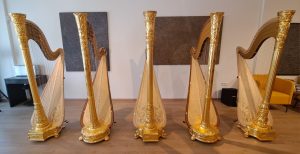
Gold harps at the Camac Harpen Nederland showroom.
In summary, listening to these great artists of the harp, one can sense the innate parallels between the harp-maker and the harpist: both of our roles are about listening and responding; each taking his cue, one from the other in order to achieve the highest possible goal through a process of rich, shared experience. Thank you to Petra, Anneleen and the Concertgebouw Orchestra for choosing Camac and, to use Anneleen’s words, together may we continue to find the ideal direction, balance and register.

